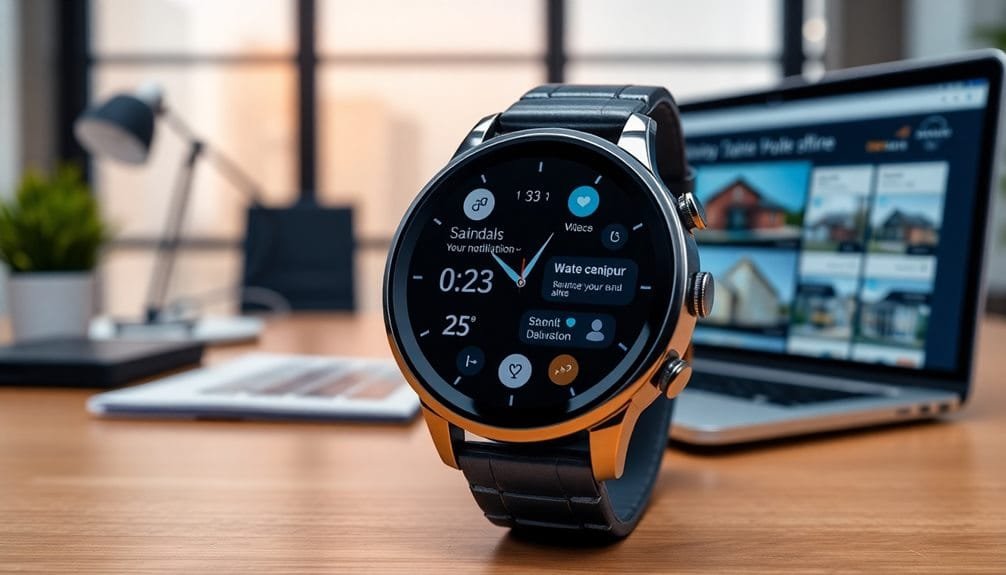To effectively use video marketing for selling properties, focus on creating diverse, high-quality videos that attract and engage potential buyers. Incorporate listing videos with drone footage or virtual tours to showcase homes and surrounding areas, offering detailed views that entice inquiries. Highlight community attractions through lifestyle videos, and build trust with client testimonials. Use platforms like YouTube, Instagram, and Facebook strategically to maximize reach, ensuring higher engagement with eye-catching visuals and storytelling. Collaborating with local influencers or experts can elevate your brand’s visibility and credibility. By utilizing these strategies, you’ll uncover more opportunities in the competitive real estate market.
Key Takeaways
- Utilize listing videos and drone footage to showcase properties and surroundings effectively.
- Engage potential buyers by incorporating virtual tours and 360° experiences for immersive property exploration.
- Distribute videos on platforms like YouTube, Instagram, and Facebook to maximize reach and engagement.
- Collaborate with local influencers to expand brand visibility and credibility in the market.
- Use storytelling and client testimonials to highlight unique features and build trust with potential buyers.
Video Marketing Strategies

When it comes to video marketing strategies for selling properties, you need to focus on creating content that stands out and captures attention. Begin by understanding that 73% of homeowners prefer listing with a realtor who uses video. This highlights the importance of integrating high-quality video content in your marketing efforts. Videos generate 403% more inquiries, so capturing potential clients’ attention is essential. Use aerial footage for a unique perspective and incorporate textual overlays with background music to enhance appeal. Videos play a significant role in lead generation by attracting 300% more traffic, nurturing potential clients effectively. Establish a personal connection through video by showcasing not just properties but the surrounding community, as 86% of homebuyers use video for community research. This approach helps build trust and communicates clearly with potential clients. With only 10% of agents currently utilizing video marketing, there is a significant opportunity to stand out by adopting this strategy. Given that 64% of clients rely solely on videos for agent contact decisions, it’s crucial to optimize all videos for search engines using relevant keywords and eye-catching thumbnails. Maintaining site reliability is key for ensuring that your videos remain accessible, so keep them short and engaging, ideally under three minutes, and post on multiple platforms, including social media and YouTube.
Types of Real Estate Videos
Exploring the world of real estate videos, you’ll find a variety of formats designed to captivate and inform potential buyers. Each type serves a unique purpose, from showcasing luxurious homes to offering educational insights. Listing videos are essential, featuring luxury listings that highlight architecture and surroundings. Drone footage provides breathtaking aerial views, while virtual tours give detailed walkthroughs of the property. Neighborhood videos emphasize local amenities and attractions, and lifestyle videos use narratives to help buyers envision living in the space. Videos provide a comprehensive view of properties, enhancing realism and giving potential buyers a more immersive experience. The use of engaging visuals increases the likelihood of inquiries to real estate agents, as potential buyers are drawn in by the captivating content.
Agent marketing videos focus on building connections. Realtor introductions help agents introduce themselves personally, and client testimonials offer authentic experiences from satisfied clients. Brand promotions on social media can enhance visibility, while day-in-the-life videos give a behind-the-scenes look at an agent’s daily activities.
For educational purposes, you can create videos providing first-time buyer tips or home seller advice. Tackling general real estate questions or diving into investing strategies can position you as an expert.
| Video Type | Purpose | Example |
|---|---|---|
| Listing Videos | Showcase properties | Luxury listings, drone footage |
| Agent Marketing | Build personal connections | Realtor introductions |
| Educational Videos | Provide valuable insights | First-time buyer tips |
| Creative Videos | Engage creatively | Animated, transformation
Best Practices for Videos

To create impactful real estate videos, adhering to best practices is key. Start by keeping your videos short and concise, as viewers’ attention spans are limited. Aim for high-quality production to stand out; invest in professional editing and soundtracks to elevate the overall presentation. High-quality videos not only get noticed but are also more likely to be remembered by potential buyers. Incorporate drone footage to provide unique, cinematic views of the property and surrounding neighborhood. This can captivate viewers and offer a perspective that traditional footage can’t match. By tracking performance metrics, you can refine your strategies to improve future video marketing efforts. Given that 73% of homebuyers prefer agents using videos for listings, storytelling should be at the heart of your video. Use narrative techniques to highlight the unique features and benefits of the property and its location, helping viewers imagine themselves living there. Including neighborhood tours can showcase local amenities, enhancing the appeal. Client testimonials are powerful tools for building trust and credibility. They offer authentic insights from those who’ve experienced the property firsthand.
Leveraging Innovative Technologies
In today’s competitive real estate market, leveraging innovative technologies can set your property marketing strategy apart. One way to do this is through Virtual Reality (VR). By using VR for property tours, you allow potential buyers to experience homes without stepping foot inside. Services like Matterport and Google Tango create multidimensional views, letting clients explore and even decide on decor from their own homes. This reduces the need for physical property visits, making the process more convenient for everyone involved. Real estate listings with video content receive 400% more replies compared to those without, highlighting the importance of incorporating video technology into your marketing efforts. In addition to VR, 360° virtual tours are a powerful tool. They capture the full beauty and scale of properties, providing immersive experiences that can be shared on social media. By enabling viewers to explore every angle, you increase engagement and interest in the property. Drone videos offer yet another innovative approach. These videos transform property showcases into cinema-like experiences, capturing unparalleled views of homes and neighborhoods. With professional execution, drone videos considerably enhance visual appeal and attract more leads. Videos are more engaging than other content types, making them an essential tool for attracting online home seekers.
Creative Content Ideas

After embracing innovative technologies like VR and drones, the focus shifts to generating creative content ideas that captivate and engage your audience.
Start with effective storytelling, a powerful tool in video marketing. By weaving narratives that help buyers visualize themselves in homes, you’ll not only evoke the emotional connection essential to purchasing a property but also guide them through the properties expertly. With 73% of homeowners more likely to list with agents who use video, compelling stories can set you apart. As 84% of consumers purchased a product after watching a brand’s video, harnessing the power of storytelling in your real estate videos can significantly boost your chances of selling properties.
Showcasing properties and neighborhoods effectively enhances your videos’ immersive experience. Incorporate 360° virtual tours to let viewers explore every corner of a property. Add drone footage for stunning aerial views that provide a professional touch.
Highlight neighborhood features by creating neighborhood spotlights that showcase local attractions and amenities, painting a complete picture of community life.
Educational content is equally important. Produce informative videos offering home buying tips or market updates, establishing yourself as a knowledgeable expert.
Use formats like “How-to” videos or “Ask me anything” sessions to engage your audience. Remember, hyperlocal content can build credibility and nurture leads, making your videos not just informative, but also invaluable to potential clients.
Choosing the Right Platforms
Steering the world of video marketing for real estate requires choosing the right platforms to maximize your reach and engagement. With 51% of home buyers turning to YouTube for property searches, it’s essential to tap into this vast audience. Platforms like Facebook and Instagram cater to different video formats; longer videos work well on Facebook for detailed tours, while Instagram thrives on short, punchy clips that showcase properties and agent profiles. Don’t overlook specialized real estate platforms like WellcomeMat for MLS compliance or Vidyard for seamless video tracking and sharing across multiple channels. Video marketing enhances visibility in a crowded real estate market, allowing agents to effectively capture and maintain the attention of potential home buyers.
| Platform | Key Feature |
|---|---|
| YouTube | Main hub for property searches |
| Best for short, engaging property videos | |
| WellcomeMat | MLS compliance and easy video upload |
Choosing the right platform also means considering integration and analytics. Vidyard and WellcomeMat provide detailed insights into video performance, helping you understand what engages your audience. Mobile optimization is another significant factor; make sure your videos are accessible on mobile devices to reach a broader audience. By carefully selecting platforms that align with these features, you can build a strong brand and efficiently manage your video marketing efforts, making certain your properties stand out in the competitive real estate market.
Maximizing Video Distribution

When it comes to maximizing video distribution, ensuring your content reaches the right audience is essential. Start by embedding videos directly into property listings, which can boost organic search results by an impressive 157%.
Social media is your ally; posting videos across platforms like Facebook, Instagram, and LinkedIn helps drive traffic to your landing page. Use hashtags to broaden your reach, and don’t forget to prioritize video quality to engage viewers effectively and build trust.
Repurposing content is another smart strategy. Break down long-form videos into shorter clips that fit seamlessly on different platforms. Create diverse content, including property tours, neighborhood profiles, and client testimonials, to keep your audience interested.
Storytelling can evoke emotions and paint a picture of the lifestyle a property offers, while live streaming Q&A sessions and property tours make interactions more dynamic.
Leverage YouTube, where 51% of prospective buyers begin their home search. Integrating videos on your website enhances listings and improves user experience.
- Prepare for Loan Maturities and Refinancing Waves as a Real Estate AgentIn mastering loan maturities and refinancing waves, uncover strategies every real estate agent needs to empower clients during pivotal financial transitions.
Collaborations and Partnerships
Collaborations and partnerships can greatly amplify your video marketing efforts. By working with local influencers or experts, you increase your brand’s visibility and reach. These collaborations not only expand your audience but also add a layer of credibility to your content.
When potential clients see you associated with trusted figures, they’re more likely to trust your brand. This trust can be pivotal in the real estate industry, where reputations matter.
Partnering with local influencers allows you to tap into new networks of potential clients. These individuals often have established audiences that align with your target market. By creating video content together, you can leverage these networks to showcase your properties to people who mightn’t have discovered them otherwise.
Moreover, collaborations enrich your video content. Imagine producing a home tour with a well-known interior designer or a local architect offering insights. This not only makes your videos more engaging but also provides valuable information to viewers.
Such partnerships can set you apart from competitors, showing potential clients that you’re connected and knowledgeable.
In essence, collaborations and partnerships are strategic moves that enhance your video marketing, driving more interest and engagement in your property listings.
Frequently Asked Questions
Recent Posts
How Can I Measure the Success of My Real Estate Video Marketing Efforts?
To measure the success of your video marketing, track key metrics like view counts and engagement rates, which show how well your content resonates.
Analyze the click-through rate to assess your calls-to-action, and monitor watch time to gauge viewer interest.
Use analytics tools for insights, compare video versions through A/B testing, and evaluate conversion rates.
This data-driven approach helps refine strategies, ensuring your videos effectively generate leads and interest.
What Budget Should I Allocate for Real Estate Video Production?
Allocating a budget for real estate video production seems straightforward, right? Just pick a number between $500 and $3,000, and you’re set.
But, consider the irony—quality, duration, and extra services complicate things. Align your budget with your marketing goals to maximize ROI.
Don’t forget local pricing trends and competitor rates. Investing in high-quality content is essential for engaging buyers.
Are There Legal Considerations for Using Drone Footage in Property Videos?
When using drone footage in property videos, you need to take into account several legal factors.
Make certain you have a Part 107 remote pilot certificate and register your drone if necessary. Obtain permission from property owners for aerial filming, and respect privacy laws by avoiding capturing private activities without consent.
Stay within Class G airspace, maintain visual line-of-sight, and only fly during allowable hours. Adhere to local ordinances to avoid legal issues.
How Do I Choose the Right Video Editing Software for Real Estate Videos?
Choosing the right video editing software involves evaluating several key features. First, make sure it’s compatible with your devices and easy to use.
Look for options with robust customization, integration capabilities, and strong customer support. Consider essential editing features like multitrack editing, changes, and color correction.
For real estate, prioritize stylized text overlays and virtual tours. Evaluate efficiency regarding speed and cost, and check user reviews.
A free trial can help decide suitability.
What Are the Common Challenges in Creating Engaging Real Estate Videos?
When creating engaging real estate videos, you face challenges like maintaining focus, ensuring quality visuals, and crafting compelling stories.
Avoid cramming too many messages into one video as it can confuse viewers. Prepare thoroughly, rehearse scripts, and dress professionally.
High-quality visuals and storytelling are key, so use technology wisely, like drone footage, to enhance appeal.
Consistency and engagement strategies, such as responding to comments, are essential for building a strong community connection.
Bottom Line
As you immerse yourself in video marketing for real estate, think of it as your Swiss Army knife—versatile and essential. By creating engaging content, leveraging cutting-edge technology, and choosing the right platforms, you’ll effectively showcase properties and connect with potential buyers. Remember, successful video marketing is about more than just visuals; it’s about telling a story that resonates. Collaborate with industry partners and maximize distribution to guarantee your message reaches the right audience, transforming views into sales.









